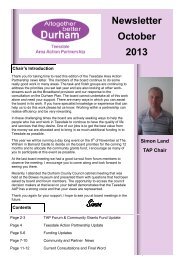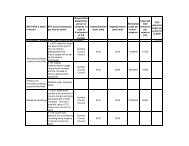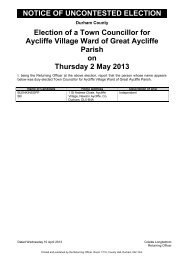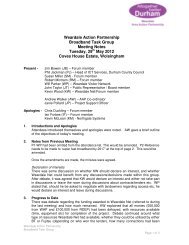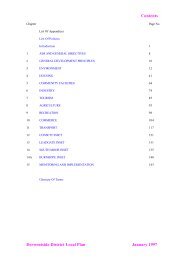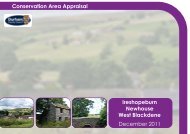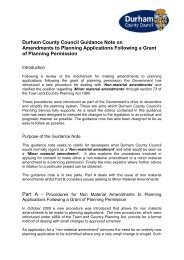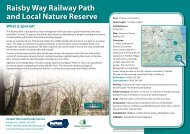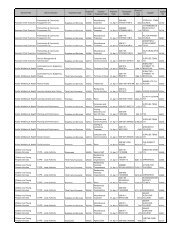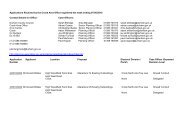SECTION 3.0 - Durham County Council
SECTION 3.0 - Durham County Council
SECTION 3.0 - Durham County Council
You also want an ePaper? Increase the reach of your titles
YUMPU automatically turns print PDFs into web optimized ePapers that Google loves.
Policy Statement 9 (PPS9) Biodiversity & Geological Conservation advises that<br />
Local planning authorities should identify these sites on proposals maps and may<br />
need to cross-refer to the statutory protection given to these sites in the<br />
explanatory texts in local development documents. However, since they enjoy<br />
statutory protection specific polices in respect of these sites should not be included<br />
in local development documents (see also Part I of ODPM/DEFRA Circular ODPM<br />
06/2005,<br />
DEFRA 01/2005).<br />
• Natura<br />
2000<br />
Natura 2000 comprises an EU wide network of nature protection areas established<br />
under the 1992 Habitats Directive. It consists of Special Areas of Conservation<br />
(SAC) and also Special Protection<br />
Areas (SPA) designated under the Birds<br />
Directive. The emphasis is on promoting the sustainable management<br />
of these<br />
sites in order to ensure the survival of Europe’s most valuable and threatened<br />
species and habitats.<br />
• EIA Directive<br />
The above nature directives along with the Environmental Impact<br />
Assessment<br />
(EIA) Directive n<br />
n of<br />
f the<br />
o late or is of poor quality (EC, 2006).<br />
4 require the assessment of potential impacts of certai<br />
developments. This includes consideration of alternatives and the desig<br />
measures to prevent and reduce negative impacts. The Commission o<br />
European Communities (2006) highlights the need for careful assessments to be<br />
carried out early on in the decision-making process. Too often EIA is conducted<br />
to<br />
•<br />
European Commission Directive 79/409/EEC on the Conservation of Wild<br />
Birds, European Union, (1979).<br />
The<br />
EU Wild Birds Directive has created a protection scheme for all of Europe's<br />
wild<br />
birds. It identifies 194 species and sub-species (listed in Annex I) among them<br />
as<br />
particularly threatened and in need of special conservation measures. In<br />
addition<br />
member states are also required to designate Special Protection Areas<br />
(SPAs)<br />
for the 194 threatened species and all migratory bird species. SPAs are<br />
scientifically<br />
identified areas critical for the survival of the targeted species, such as<br />
wetlands.<br />
The designation of an area as a SPA gives it a high level of protection<br />
from<br />
potentially damaging developments. All SPAs in the UK are also nationally<br />
designated<br />
as Sites of Special Scientific Interest, (SSSIs). The Directive is<br />
transposed<br />
into the UK by the Conservation (Natural Habitats etc) Regulations<br />
1994.<br />
Planning Policy Statement 9 (PPS9) Biodiversity & Geological Conservation<br />
advises<br />
that Local planning authorities should identify these sites on proposals<br />
maps<br />
and may need to cross-refer to the statutory protection given to these sites in<br />
the<br />
explanatory texts in local development documents. However, since they enjoy<br />
statutory<br />
protection specific polices in respect of these sites should not be included<br />
in local development documents (see also Part I of ODPM/DEFRA Circular ODPM<br />
06/2005,<br />
DEFRA 01/2005).<br />
4 Directive 85/337/EEC as amended by Directive 97/11/EC, OJ L 073, 14.3.1997, p.5<br />
Page 11 4/15/2009




